Table of Contents
Introduction
Starting an online business can be both exciting and challenging, especially when choosing the right platform to showcase your products. For creatives and artisans, Etsy is a top choice, offering a marketplace where handmade, vintage, and unique items thrive. With millions of active buyers worldwide, Etsy provides an opportunity to reach a global audience passionate about unique goods.
This guide will walk you through the essential steps to get started on Etsy, from setting up your shop to attracting your first customers. Whether you’re just considering opening a shop or are in the early stages, this post will equip you with the knowledge and tools to succeed.
Let’s dive into the world of Etsy and discover how you can turn your creativity into a profitable online venture.
1. Understanding Etsy’s Marketplace
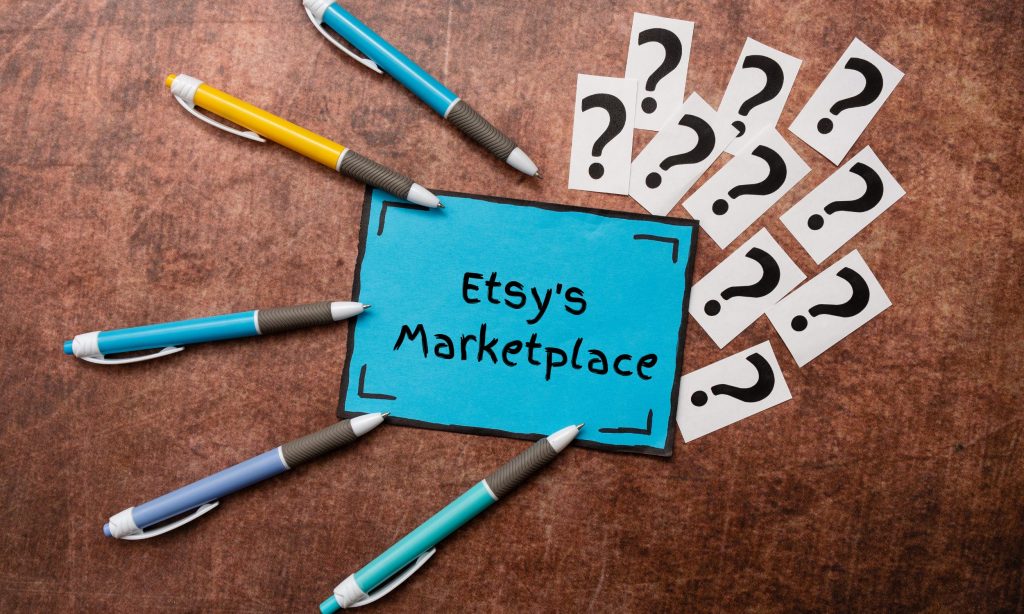
Before diving into selling on Etsy, it’s crucial to understand the marketplace’s dynamics. Etsy is known for its niche focus on handmade, vintage, and unique items, which appeals to a specific audience of buyers looking for something special. This focus shapes the types of products that thrive on the platform and can guide you in determining what to sell.
Popular Categories on Etsy
Etsy’s marketplace is diverse, but some categories stand out for their popularity among both sellers and buyers. For example, the Home & Living category is by far the largest, with over 1.1 million active shops and more than 28 million listings. This category encompasses a wide range of products, from home décor to furniture and kitchenware, making it a popular choice for new sellers.
If you’re considering a category based on sales potential, Craft Supplies & Tools is noteworthy. Shops in this category boast the highest average sales per shop, with an impressive 2,102 sales on average. The Wedding category also performs well, with an average of 985 sales per shop, driven by a high demand for personalized and unique wedding items.
For a more detailed breakdown of categories and insights into where your products might fit best, check out this resource on top Etsy categories.
Understanding Your Audience
Etsy’s audience is largely composed of buyers who appreciate the value of handcrafted and unique items. They are often willing to pay a premium for products that reflect creativity, quality, and originality. This means that sellers who focus on crafting unique items that stand out are more likely to succeed.
2. Preparing to Open Your Etsy Shop
Before you open your Etsy shop, there are a few key steps to take that will set the foundation for your success. This phase is all about defining your niche, developing your products, and establishing a strong brand identity that will resonate with your target audience.
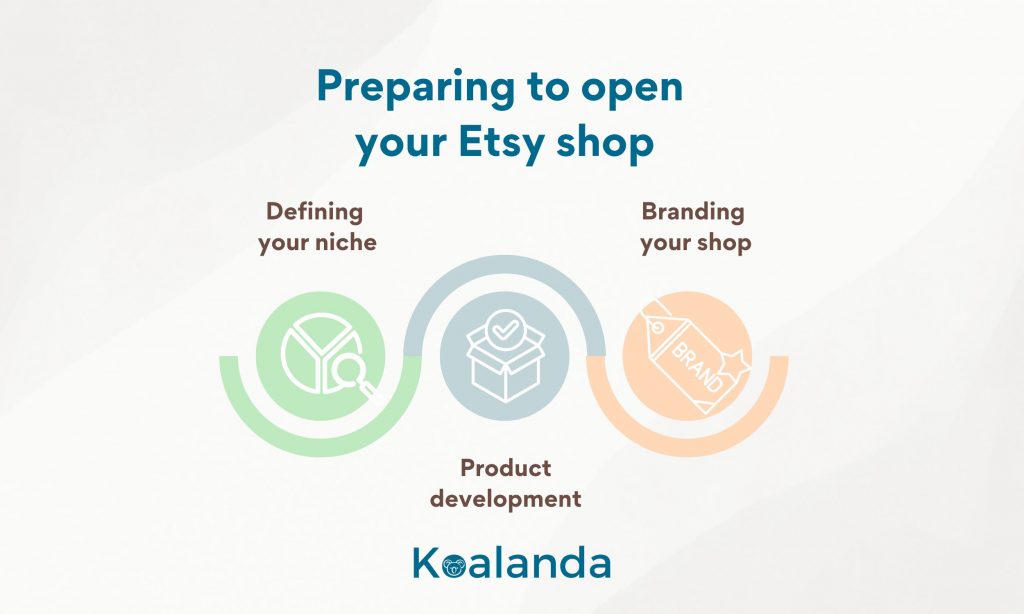
Defining Your Niche
The first step is to identify what makes your products unique and appealing. Etsy is a marketplace where creativity and originality shine, so think about what sets your items apart from others. Whether it’s a particular style, material, or theme, having a clear niche can help you attract the right customers and stand out in a crowded market.
Product Development
Once you’ve defined your niche, focus on developing a consistent and high-quality product line. Take the time to perfect your products, ensuring they meet the standards that Etsy shoppers expect. High-quality materials, craftsmanship, and attention to detail will help build your reputation and encourage repeat business.
Branding Your Shop
Your brand is more than just a logo—it’s the story, style, and personality that your shop conveys. A strong brand helps customers remember you and builds trust in your products. Here’s how to start building your brand:
- Choosing a Shop Name: Your shop name should be memorable, reflect your products, and be easy to spell. It’s worth checking if the name is available as a domain if you ever want to create a website or blog to support your shop.
- Designing a Logo: A professional-looking logo is an essential part of your brand identity. Tools like Canva make it easy to create a logo, even if you don’t have design experience. Canva offers a variety of templates that you can customize with your shop name, colors, and style. Other options include Hatchful by Shopify, which also provides user-friendly logo creation tools.
- Creating a Cohesive Brand Aesthetic: Beyond the logo, consider the overall aesthetic of your shop. This includes your product photography, shop banner, and even the language you use in your product descriptions. Everything should align with the story you want to tell and the emotions you want to evoke in your customers.
By carefully preparing your shop’s foundation—defining your niche, developing quality products, and creating a cohesive brand—you’ll be well on your way to making a strong first impression on Etsy.
3. Setting Up Your Etsy Shop
With your foundation in place, it’s time to bring your Etsy shop to life. Begin by creating an Etsy account or logging in via the Etsy Sell page. Start by setting your shop preferences, choosing your language, country, and currency.
Next, name your shop—a unique and memorable name that reflects your brand. Etsy will check if your chosen name is available.
Once your shop is named, it’s time to stock your shop. Create your first product listings with high-quality photos, descriptive titles, and detailed descriptions. Include relevant keywords, set prices, and configure your shipping options. Well-crafted listings are crucial to attracting buyers.
After stocking your shop, you’ll need to choose how you’ll get paid by setting up Etsy Payments. Enter your banking information to receive funds directly into your account.
Then, set up billing to cover Etsy’s fees, such as listing fees and transaction fees. Depending on your location, Etsy may also require you to verify your identity for added security.
Finally, review all the details and open your shop to the public. You can refer to Etsy’s official guide or their video tutorial for a more in-depth walkthrough.
4. Pricing and Financial Considerations
Setting the right prices for your products is crucial to your success on Etsy. Not only does your pricing need to cover costs and generate profit, but it also needs to be competitive within your niche.
Pricing Your Products
When pricing your products, consider all your costs, including materials, labor, and overheads, along with Etsy’s fees. Research similar items on Etsy to gauge the market rate, but don’t undervalue your work—factor in the uniqueness and quality of your products.
Etsy Fees
Etsy’s fee structure is relatively straightforward, but it’s important to understand how these fees impact your bottom line:
- Listing Fee: Etsy charges a $0.20 fee per item listed. This fee is renewed every four months or when the item sells, whichever comes first.
- Transaction Fee: When an item sells, Etsy takes a 6.5% transaction fee on the sale price, which includes the shipping cost you set.
- Payment Processing Fee: This fee varies by country. For U.S. sellers, it’s 3% of the total sale price plus a $0.25 flat fee per transaction. In most of the EU, the fee is 4% plus a 0.30 EUR flat fee. Remember, these fees apply to the total sale amount, including shipping.
- New Shop Set-Up Fee: Some new shops are subject to a one-time set-up fee of $15 before they can start selling.
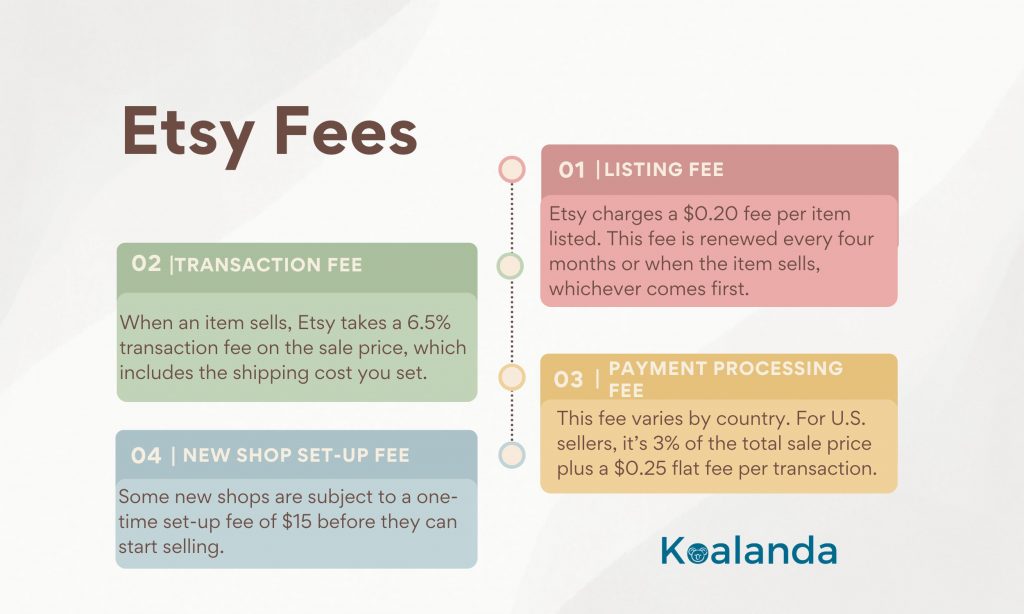
While these fees might seem minor individually, they can add up, especially for lower-priced items. It’s crucial to factor them into your pricing strategy to ensure profitability.
Tax Considerations
Tax obligations vary by country, so it’s essential to understand your responsibilities. Consulting a tax expert in your country is advisable to ensure compliance. Joining local Etsy seller groups can also be helpful, as they often share valuable insights on managing taxes and other financial considerations.
By carefully considering your pricing strategy and understanding Etsy’s fee structure, you can ensure that your shop remains profitable while offering competitive prices.
5. Promoting Your Etsy Shop
Once your shop is up and running, the next step is getting it noticed by potential buyers. Effective promotion is key to driving traffic and increasing sales.
Optimize for Etsy SEO

Search Engine Optimization (SEO) is crucial for getting your products found on Etsy. By using the right keywords in your titles, descriptions, and tags, you can improve your shop’s visibility in search results. Start by researching popular keywords relevant to your products and incorporate them naturally. To refine your keyword strategy, consider using tools like Koalanda. Learn more about discovering the best keywords for your Etsy listings to boost your SEO efforts. For more tips, check out this guide on Etsy SEO for Beginners and explore a glossary of Etsy SEO terms to better understand the terminology.
Utilize Etsy Ads
Etsy offers paid advertising options that can help boost your listings’ visibility. Etsy Ads allows you to promote your products across the platform, targeting customers who are likely to be interested in your items. Before diving in, it’s important to assess whether Etsy Ads are worth the investment for your shop. This article on Etsy Ads and another on using Etsy Ads effectively provide detailed insights on how to make the most of your ad budget.
Leverage Social Media
Promote your Etsy shop through social media platforms like Instagram, Pinterest, and Facebook. These platforms are great for showcasing your products, sharing behind-the-scenes content, and engaging with potential customers. Consistent posting and interaction with followers can build a loyal customer base over time.
Engage with the Etsy Community
Joining Etsy Teams or participating in forums can help you connect with other sellers and learn from their experiences. Being active in the Etsy community can also increase your shop’s visibility and help you stay informed about best practices.
By implementing these strategies, you can effectively promote your Etsy shop, drive more traffic, and increase your chances of making sales.
6. Managing Your Etsy Business
Once your shop is up and running, effective management is key to maintaining and growing your business. This involves staying on top of orders, providing excellent customer service, and continually analyzing your shop’s performance.
Order Management
Managing orders efficiently is crucial to maintaining customer satisfaction. Make sure to process orders promptly, keep customers informed about shipping, and handle any issues that arise professionally. Timely communication and reliable shipping are essential for building a positive reputation on Etsy.
Tracking Your Progress
To ensure your shop is on the right track, it’s important to regularly analyze your sales data and performance metrics. This is where Koalanda can be an invaluable tool. The My Orders section of Koalanda provides powerful tools for viewing and analyzing your orders. It offers various statistics and metrics about your orders and top-selling listings, allowing you to dissect the data by country, time period, or even by listing.
With the My Orders tools, you can identify important trends and patterns in your sales. For instance:
- Discover which countries are your top markets.
- Identify the most popular listings in specific countries.
- Analyze whether you’re receiving enough repeat orders.
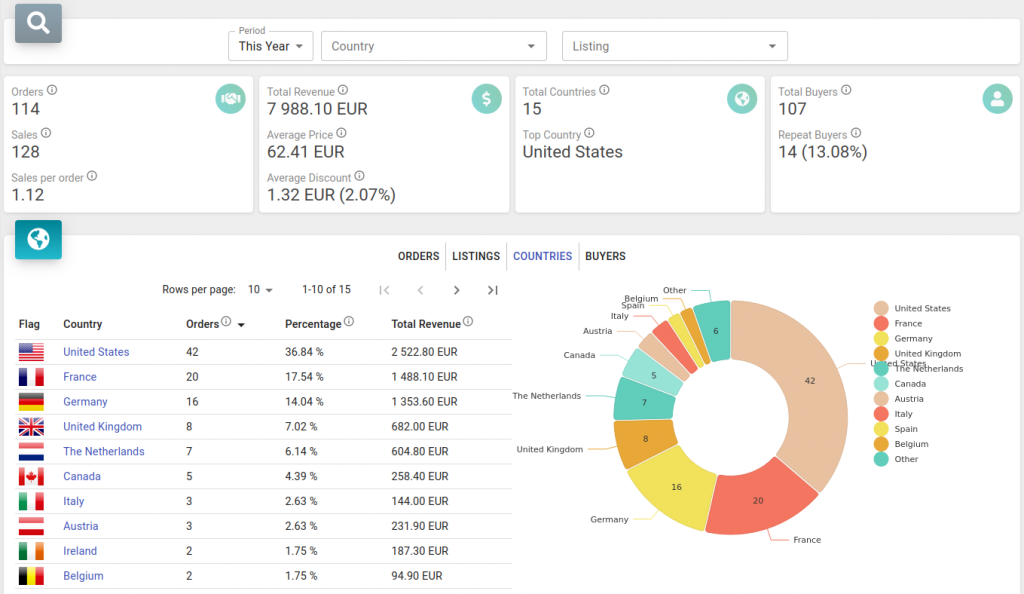
These insights can help you make informed decisions about product development, marketing strategies, and customer engagement. For a comprehensive overview of other essential Koalanda tools, you can explore this Koalanda overview.
Customer Service
Providing excellent customer service is crucial for maintaining a positive reputation on Etsy. Be prompt in responding to customer inquiries, handle issues professionally, and go the extra mile to ensure customer satisfaction. Happy customers are more likely to leave positive reviews and become repeat buyers.
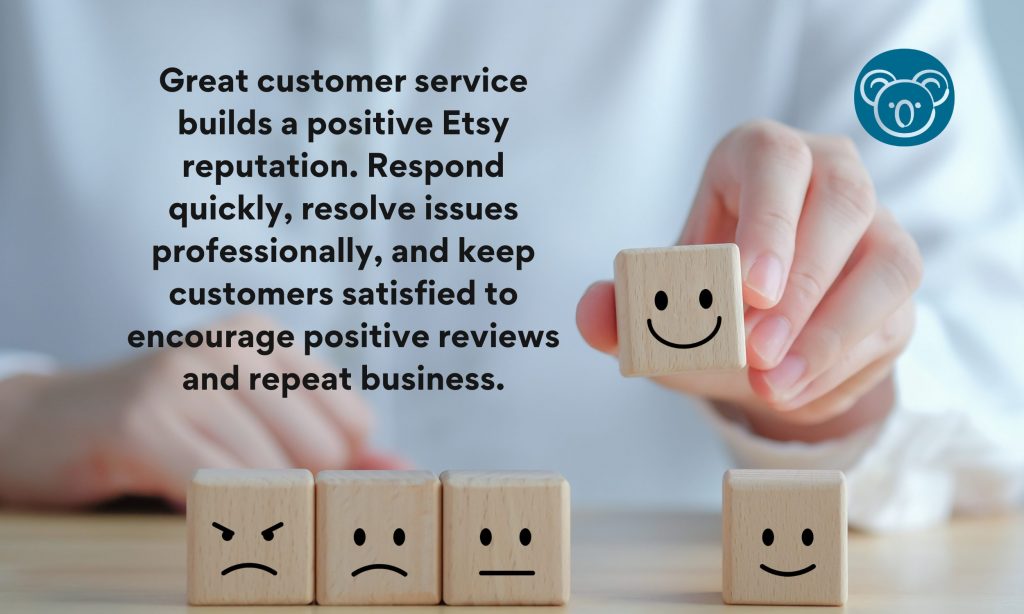
Inventory Management
Keeping track of your inventory is essential to avoid overselling and to ensure that you can fulfill orders on time. Regularly update your listings to reflect current stock levels and plan ahead for busy seasons by managing your inventory accordingly.
By effectively managing your Etsy shop using these strategies and tools, you can ensure smooth operations and position your business for long-term success.
7. Growing Your Etsy Shop
It may seem early to think about growth, but laying the groundwork now can set you up for long-term success.
Expand Your Product Line
Adding new products that complement your existing offerings keeps your shop fresh and attracts more customers.
Build Customer Loyalty
Focus on excellent customer service and offer perks like discounts or loyalty programs to encourage repeat business. Small gestures like thank-you notes can also help build strong relationships.
Use Analytics
Leverage tools like Koalanda to track performance and spot trends. Data-driven decisions can help optimize your listings and boost sales.
Enhance Marketing
Continue promoting your shop through Etsy Ads, social media, and partnerships with other sellers. Consistent marketing helps attract and retain customers.
Connect with Other Sellers
Networking with other Etsy sellers through teams or forums can provide valuable insights and growth opportunities.
By focusing on these areas, you can steadily grow your Etsy shop and build a sustainable business.
Conclusion
Starting an Etsy shop is an exciting venture that combines creativity with entrepreneurship. While it may seem overwhelming at first, by following the steps outlined in this guide, you can set a strong foundation for your shop’s success. From understanding the Etsy marketplace and setting up your shop, to managing your business and planning for growth, each step is crucial to your journey.

Remember, success on Etsy doesn’t happen overnight. It requires dedication, continuous learning, and a willingness to adapt. Utilize tools like Koalanda to optimize your efforts, connect with other sellers for support, and keep experimenting with new strategies.
Most importantly, enjoy the process. Etsy is a platform where your unique products can shine, and with the right approach, you can turn your passion into a thriving business.Explore more helpful content on our blog to continue learning and optimizing your Etsy journey!





